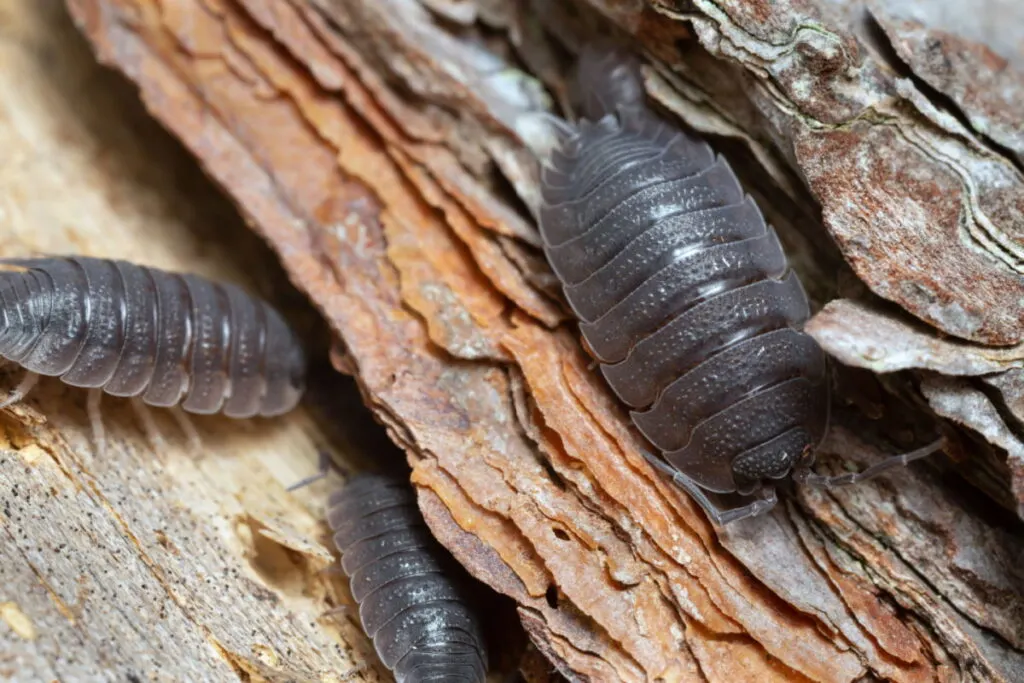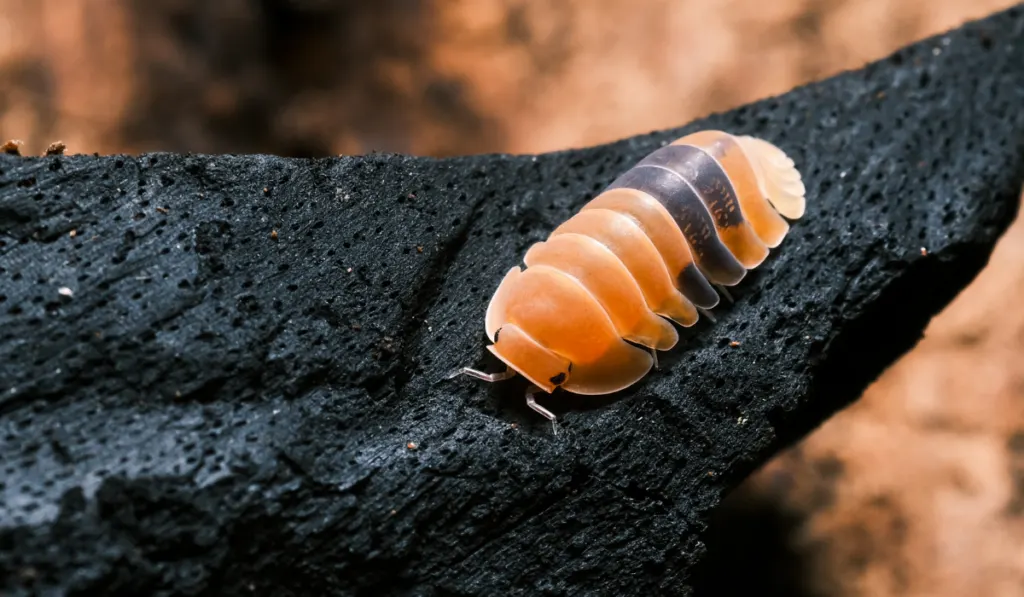Scientists estimate that there are about 10,000 species of isopods in the world. On land, you will find small isopods in damp and protected areas like under logs, rocks, garden mulch, and giant isopods on large water bodies. They belong to the order “Isopoda” and are the most diverse of the crustacean groups.
Table of Contents
What are Isopods?
Isopods are invertebrates, similar to insects and crustaceans. Isopods are pill bugs or roly polys that you may have come across in your garden or on a hike. They make up a vast and important part of the biological world.
They have an overlapping thorax and abdomen, and that is why they are called “isopods.”
You’ve probably seen these around before, in damp areas of your garden and home.
Land isopods come in many sizes and shapes, but they all share certain characteristics: they have seven pairs of legs, two pairs of antennae, and a single pair of eyes which are simple eyespots with no lens. Their bodies are segmented and covered with a hard exoskeleton.
If you have considered getting isopods for your terrarium or your aquarium, don’t hesitate! They come in many interesting colors and sizes.

Common Types of Isopods
There are many types of isopods in the world, but the most common types are:
- Woodlouse (terrestrial)
- Giant isopods (aquatic)
- Pillbug/roly-poly (terrestrial)
7 Key Benefits of Isopods
Here are some of the key benefits of isopods:
- Consume waste – Isopods help reduce waste both on land and sea. Terrestrial isopods thrive on eating decaying matter like fallen decaying plants, leaves, fecal material, dead animals, mold, and they help break down harmful products that plants can use.
You will also find another type of isopods in the cold deep waters of the Indian, Atlantic, and Pacific oceans. These isopods are carnivorous and eat dead squid, fish, whales, and other sea animals, thus, they are helpful in cleaning bodies of water.
- Add Nutrients to the soil – Other than being scavengers, isopods are also big helpers in adding nutrients to the soil. Isopods prefer feeding on decaying matter which they find palatable and easier to consume. When terrestrial isopods eat decaying matter, they contribute to nutrient recycling in the soil. Isopods contribute to a high-quality organic matter in the soil thus increasing the microbiome that helps in nutrient cycling.
- Helps in-the-field study – Isopods play an important role in helping scientists better understand marine life. They are used in experiments as a substitute for coral reefs since they live in similar areas with similar conditions. Scientists often take them out of their natural habitat to study them and learn more about their biology and pollution in the water.
- Food source for predators – Isopods are a food source for many different animals. Predators such as beetles, centipedes, spiders, and other small animals eat terrestrial isopods. As for aquatic isopods, any predator bigger than them can eat them. However, to prevent being food to predators, isopods usually curl up to protect their soft underside.
- Fertilize plants and aerate the soil – As isopods move around, they dig small tunnels in the soil. These tunnels make voids that allow air to go deep down into the substrate layer. These tunnels help water to move further down, thus preventing waterlogs and helping plants grow. At the same time, the waste from isopods (frass) is good fertilizer for plants.
- They are low maintenance – Isopods are low maintenance, and if you choose to have some for your terrarium, you do not need to feed them much, as they will eat anything from vegetables to leftover fish food. This means that they are easy to care for even if you don’t have a lot of time on your hands.
- Good for your tank – Since they eat decaying plants, keeping isopods will help maintain the balance of oxygen and carbon dioxide in the water by preventing algae growth. You won’t have to clean the aquarium as often because they will do some of the work for you, thus helping to keep the water quality high for your fish and other aquatic pets.

Isopod Care and Habitat
Since you have seen how important isopods are, how best can you care for them? Well, isopods require minimal maintenance. A humid environment is ideal for the survival of land isopods as they are related to crabs, shrimps, and lobsters.
Offer them additional food such as food flakes, leaf litter, dog chow, raw potatoes, carrots, and apples.
Their habitat should receive indirect light (place them in dimly lit areas) and have a temperature of 68 to 72°F (20 to 22°C). Since land isopods have gills and need a moist environment to survive, ensure that you mist the habitat daily for the isopods to have the appropriate level of humidity.
Remember: Terrestrial isopods will drown if you submerge them in water for too long.
Frequently Asked Questions (FAQs) About Isopods
Where can I find isopods?
You can get isopods from pet stores, but if you want to save money, you can dig around in decaying wood or leaf litter to find some pill bugs in the wild. You might also see them on plants in your garden, under stones or logs, or even crawling on your compost pile.
What is the lifespan of isopods?
In nature, adult isopods can live for approximately one and a half years, while some species can live for two years or more. They live longer in moist habitats and curl up to expose their hard outer shell, thus protecting themselves from potential predators. In captivity, isopods live three to four years.
What do isopods eat?
Terrestrial isopods feed on dead and decaying vegetation, fungi, mold, fungal spores, lichen, mosses, and algae. Aquatic isopods feed on a variety of food as well. The marine species feed mainly on dead fish and other types of small aquatic animals.

Are terrestrial isopods and aquatic isopods the same thing?
No. Terrestrial isopods are land-dwelling, while aquatic isopods live in water. Terrestrial species of isopods are crustaceans, like their cousins, the pill bugs. Aquatic isopods are also crustaceans, but they’re related to shrimp and lobsters.
Are isopods harmful to humans?
Isopods are not harmful to humans. They have sharp claws to help them adapt well to the ecosystem, but they are not capable of causing physical harm to humans.
Why do isopods have a hard exoskeleton?
The hard exoskeleton helps isopods to curl and protect themselves from potential danger. They also curl up to conserve energy when they don’t have enough food or moisture.
Key Takeaways
Isopods are a fascinating species that have become increasingly popular as pets. This is due to their ability to keep the tanks of other reptiles and fish clean. They live in the floor litter of forests and feed on decaying matter. They have gills, so you need to keep their environment moist at all times.
Isopods come in many different species, ranging from dwarf species to giant ones, which can measure up to 12 inches in length.
Isopods are a great addition to the aquarium hobby. You will enjoy watching their interesting behaviors and caring for them since maintaining them is relatively low maintenance if you are looking to purchase either terrestrial or aquatic isopods.
You will find that majority of the species available in the aquarium trade will do well in most community tanks.
Resources
- https://oceanexplorer.noaa.gov/facts/isopod.html
- https://www.microgreening.com.au/blog/introduction-to-isopods-in-terrariums
- https://en.wikipedia.org/wiki/Giant_isopod
- https://pubmed.ncbi.nlm.nih.gov/12475050/
- https://www.researchgate.net/publication/329374222_Terrestrial_isopods_as_model_organisms_in_soil_ecotoxicology_A_review
- https://sciencing.com/isopod-life-cycle-12206033.html
